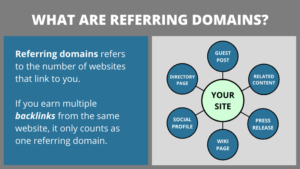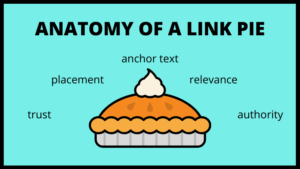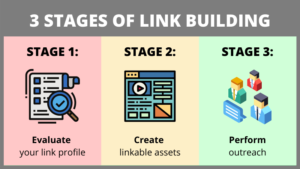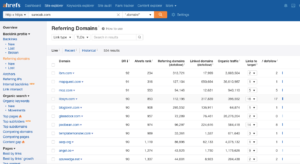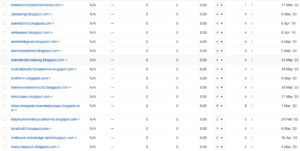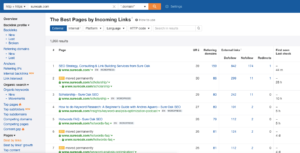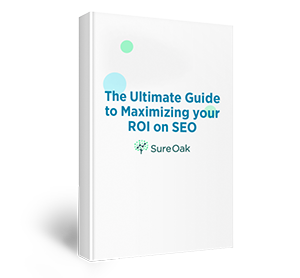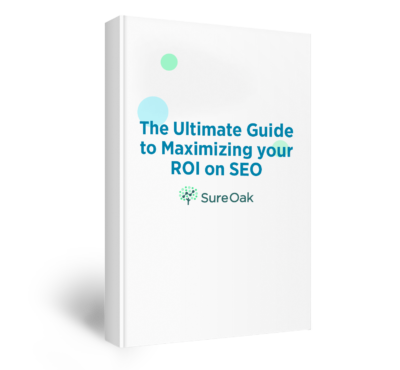Building links is probably the most vital piece of the SEO puzzle – so why does it have to be so confusing?
Although we consider ourselves backlink pros, believe us when we tell you that we feel your pain. We’ve been there and we know that the struggle is real.
That’s why we wrote this guide – to share what we’ve learned on our journey to becoming link building experts.
If you’d like to know how to build white-hat backlinks to boost your SEO, you’re in the right place. In this guide, we’ll cover everything you need to know about link building—and we’ll do so in plain English.
Let’s start at the very beginning:
Part 1: What is Link Building?
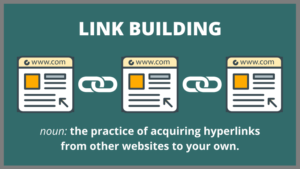
Links have affected search rankings ever since Google began operating, and they still play a huge role today.
To put it simply, search engines interpret links as “votes” for your website. These “votes” are tallied by Google’s PageRank algorithm to determine the importance of your website.
Naturally, if your website is perceived to be more important than those of your competitors, you will appear higher in the search rankings.
So in a nutshell, the more high-quality links you have pointing to your website, the more likely you are to outrank your competitors.
Google also uses links to decipher what your web pages are about, and this process can help your search rankings as well.
The bottom line: link building is the backbone of any effective SEO campaign, and that’s why we prioritize it at our agency.
How Many Links Do I Need To See Results?
You now know why backlinks are essential in order to be found on Google, but just how many do you need?
In short, the number of backlinks that you’ll need to rank depends on two key factors: your current domain authority and your SEO competition. For our clients, we give rough estimates of how many backlinks they’ll need based on these two variables.
Domain Authority
Backlinks serve to improve your website’s authority on the web. By building links to important pages on your site, those pages gain authority and so does your domain.
If you have a brand new website, you’re starting from ground zero in terms of authority. This means that you’ll likely need more links to compete with other, more established websites. On the other hand, if you happen to own an established website, it will take fewer backlinks to rank for the keywords you’re after.
SEO Competition
Due to the ranking system adopted by search engines, SEO is a competitive sport—and your chance of ranking for a keyword depends on how many links your competitors have.
In some industries, businesses have not prioritized backlinks as part of their SEO strategies. In these cases, websites require fewer links to outrank competitors. The possibility of this was much more common a few years ago.
Each year, thousands of businesses begin building links on a regular basis. If your competitors have been working on their SEO for a long time, outranking them will be a struggle. If this is the case, you’ll need a high amount of links to outrank them.
How Long Does It Take To See Results?
Once you’ve built your first link, how quickly will your rankings shift? As is the case with most link building questions, the answer isn’t so simple.
In general, it takes about 3 months to begin seeing results from link building activity. To see the fully-realized results, though, you usually have to wait 6 months to a year.
It’s important to note that this is a rough estimate. Organic search rankings depend on thousands of factors, so your mileage might vary. This is why we can’t provide a one-size-fits-all answer.
Part 2: Which Links are Best?
Before you begin building links, you should know that all links are not created equal.
The best links will bring a huge ranking boost for your website, while the worst links will actually hurt your SEO.
This is the primary danger of link building: if you accidentally create a link that looks unnatural or spammy, search engines could penalize your site.
So how can we be certain that we’re building the good links, while simultaneously avoiding the bad ones?
The answer to this question is complicated, but we can boil it down to a few factors.
The Anatomy of a Quality Link: 5 Key Factors
If we were to compare a backlink to food, the most apt choice would be a pie.
To expand this (yummy) metaphor, baking a link pie involves 5 important “ingredients.” Just like a real pie, a link pie will only taste as delicious as the quality of the ingredients.
Here are those ingredients:
- Relevance
- Trust
- Authority
- Placement
- Anchor Text
While each one of these ingredients is important, we tried our best to arrange our list based on the impact each factor will have on your rankings.
To get a clearer picture of our link pie, let’s break down each ingredient.
1. Relevance
In our link pie, relevance is the filling. Just like you wouldn’t fill a pie with dish soap, you shouldn’t build a link that isn’t relevant to your site.
Let’s say a fitness blog writes a post about the best protein powders on the market. Within that post, the author links to two companies: Company A and Company B.
- Company A sells protein powders;
- Company B sells leather wallets.
Since the article in question is about protein powder, a link to Company A has more relevance within the context of the article, thus they will receive the most link equity from this post.
Meanwhile, it would be quite the stretch for Company B to make sense in the context of this article, and that means the link has a low relevance factor.
In our experience, relevance plays a huge role in how much equity your website will inherit from a new link.
2. Trust
It doesn’t matter how tasty your link pie is. If Google doesn’t trust the integrity of your link, the entire pie will fall apart. In this way, trust is like the crust that holds our link pie together.
For example, it’s safe to say that Google trusts Forbes.com much more than they would a new domain with no content. This is because Forbes has established a reputation for creating informative content on the web, while a brand new domain has yet to do so.
The difference in trust that Google has for these two sites is reflected in their organic rankings: Forbes can rank for highly competitive keywords, while a brand new website will struggle to rank for anything.
To evaluate trust for link building purposes, some SEOs rely on a metric like Majestic’s Trust Flow. While this is a reasonable approach, we prefer to use our own judgment paired with the aforementioned insight.
When evaluating link opportunities, we use Ahrefs to see how many keywords a site is ranking for.
If a site doesn’t rank for many keywords other than its brand name, we usually pass on that opportunity.
3. Authority
Authority is a big buzzword in the SEO space, and for good reason: the more authority a domain has, the more equity your site will inherit from its link.
In this way, authority is the link pie. Like the diameter of the crust determines the size of our pie, the amount of authority determines the overall value of our link.
Authority isn’t just about links, though. The more authority your domain has, the easier it will be to rank for a given keyword. Lucky for us, we can build authority by getting new, high-authority links. This is arguably what makes link building so valuable—it eventually converts to higher search rankings.
To evaluate authority, we use Moz’s Domain Authority metric, which calculates a domain’s score based on the links pointing to it. To find the Domain Authority score for a website, you can use our free domain authority checker, or you can use the Moz browser extension to find it automatically.
4. Placement
When you put a real pie into the oven, placement matters. If your pie is too close to the heat, it will burn. Placement largely works the same way for links.
The higher your link appears on the page, the better. That means it’s much more valuable to get a content link than it is to get a footer link.
Of course, it’s important to remember relevance as well. If your link doesn’t “fit” within the paragraph, the link won’t make a difference at all. This is why we prioritize relevance first.
5. Anchor Text
Anchor text is what we call the visible words that a link displays. It’s usually highlighted in a different color to make the link stand out among the rest of the text.
To stick with our metaphor, anchor text is like putting a label on the pie. If you label your link pie incorrectly, Google might get angry with you.
Until recent years, Google relied on anchors in order to decipher what a page was about. This made anchor text the most important component of a link.
Unfortunately, people began to exploit this function, and Google was forced to modify their algorithm. Now, anchor text plays a much smaller role in a site’s SEO, but this factor does retain some significance.
Choosing the right anchors for your links is a tricky game, and you could get burned if you do it incorrectly. It’s entirely possible to over–optimize and harm your rankings with too many exact-match anchors. That’s why we generally default to what looks natural, and we try our best to use a variety of anchor types when we build multiple links at a time.
A Note on “Dofollow” vs. “Nofollow” Links
There’s one more important aspect of a link’s anatomy, and that’s the “rel“ attribute.
When a rel= tag is attached to an outbound link, it acts as a signal to search engines. “rel=nofollow” means that the link won’t count as an endorsement, while a “rel=dofollow” tag means that it will.
The “nofollow” tag typically occurs on things like blog comments, social media posts, and Wikipedia. While “nofollow” links aren’t totally useless, they aren’t nearly as valuable as “dofollow” links.
So when it comes to SEO, you want to maximize your “dofollow” links, while sprinkling in a few “nofollow” links as well.
Part 3: How Do I Start Building Links?
As we’ve covered in this article, links play a substantial role in how search engines perceive websites. Without adding new backlinks on a consistent basis, it will be difficult for a site to maintain its current search rankings, and even harder to improve them.
Both Google and Bing have gone on the record to say that you shouldn’t “try” to get new backlinks. In their view, you should simply produce amazing content, and the links will follow.
While this would be amazing in a perfect world, the reality of SEO is very different. Even if you do produce phenomenal content, search engines won’t give it a chance to rank unless it has backlinks—and if Google isn’t ranking your content, how will other webmasters find it in the first place?
Here’s the bitter truth: it’s not feasible to simply wait around for those backlinks to arrive while you stare at your stellar content. Rather than trying to win backlinks, you’ll have to earn them instead. This will require a strategy.
In this section, we’ll show you the three stages we use to form backlink strategies.
Stage 1: Evaluate Your Link Profile
Before building new links to your web pages, you should first examine the links that you currently have. While this might seem unproductive, we highly discourage you from skipping this step. Evaluating your link profile will not only tell you where you presently stand, but it will also guide you to the best backlink strategy for your site.
To begin, you’ll need to perform a backlink analysis. During a backlink analysis, you’ll examine the links pointing to your site. This will produce two primary insights:
- Whether you have any backlink issues that need to be addressed, and
- How you’ve gained backlinks so far.
Let’s start with the first part.
How To Check for Backlink Issues
If your domain has been around for a while, it has likely accumulated some low-quality spam backlinks. This is normal, and Google can usually determine that you were not involved in building these links.
Sometimes, though, a site will have an abnormally large number of spam backlinks, and this could potentially hurt its reputation with Google’s web crawler. We commonly see this in domains that were previously hacked, as well as domains that have been hit with a negative SEO attack.
In both of these scenarios, the best course of action is to identify these low-quality backlinks and “disown” them using Google’s disavow tool.
So how can we detect these low-quality spam links in order to disavow them?
There are many tools that can help you with this, but the tool we use the most is called Ahrefs. Out of all the SEO tools, Ahrefs has the largest backlink index, and they scan for new backlinks regularly. This is ideal, as it reduces the risk of missing important backlinks.
How does that look in practice? By plugging our domain into the Ahrefs site explorer and clicking on “referring domains” in the left sidebar, we can see a list of the domains with a link pointing to us.
If we click on “DR” to sort by Ahrefs’ authority metric (known as domain rating), Ahrefs gives us a list of backlinks with very little authority
If you remember from Part 2 of this guide, authority is one of the big factors that determines how much value you’ll get from a link. Since these links have low authority, we aren’t gaining much from them—and since they’re low-quality, these links could actually be hurting our rankings.
You can export this list and create what’s known as a disavow file. Then, just submit that file to Google. This is our way of telling Google that we don’t approve of these links.
How to See Top-Linked Pages
Now, it’s time to examine how we’ve acquired our current backlinks. We can then use this knowledge to inform the backlink strategy that we’ll be forming soon.
By typing our website into Ahrefs’ site explorer and navigating to the “best by links” item (in the left-hand column), we can see the pages on our website that have attracted the most links.
By checking the “referring domains” column on this page, you can see how many domains have linked to each page.
It looks like our homepage is the most popular, which is common for most websites. As we move down the list, though, we see some content pieces that have attracted quite a few links.
Here’s a quick sampling of our top-linked pages:
Each of these pages serves a different purpose, but they all have one thing in common: they get links.
That’s pro-tip #1: now that we know what has worked for us in the past, we can use that information to decide what might work for us in the future.
And pro-tip #2? You can use this tool to spy on your competitors. Just repeat this process, but instead of your own site, you’ll plug in a competitor’s.
Step 2: Identify and Create Linkworthy Assets
Although this article is about “link building,” it will be difficult to earn high-authority links if you don’t have at least some content that others want to share.
During our last example, we looked at what pieces of content attracted the most links. These are great starting points, as they’ve already proven themselves as “link-worthy” assets.
However, this doesn’t mean that you shouldn’t continue to create fresh content that provides value to your readers. Content is king, and value is the cornerstone of SEO.
We encourage you to get creative with your content. Try your best to form something that none of your competitors have—perhaps a massive guide or an industry-specific survey that yields surprising results. The more thought you put into your content now, the easier it will be to earn backlinks later.
Once you have these pages, they will act as targets for your link-building campaign.
Step 3: Perform Outreach
Now that you’ve assessed your current link profile and identified a few targets, it’s finally time to get out there and earn some links.
Here’s a quick warning: this step tends to be the most tedious. Especially if you’re new to link building, it’s important that you pace yourself to avoid getting discouraged or burned out.
There are hundreds of link building strategies, but nearly all of them involve promoting your content through outreach. As we said, it’s not practical to hope that someone stumbles across your website. Instead, you’ll need to put your site on other people’s radars.
Let’s break this step down into actionable tasks:
- Create a list of websites that might be willing to link to you;
- Find contact information for each website;
- Reach out to those contacts and pitch them your content.
All of this is simple enough, but the true challenge is doing it efficiently. The success of your link building campaign will depend on it.
How do you know which sites are willing to link to you? While the long answer is more nuanced, the short answer is you don’t. That’s why this stage can be so strenuous, especially if you’re running the wrong strategy.
Final Thoughts
The importance of link building cannot be understated. While there are many ranking factors that affect SEO, high-quality links remain integral to outrank your competitors.
We hope this guide has helped you understand the logistics behind link building. As complicated as it may seem, our philosophy is simple: when it comes to building links that will withstand the test of time, there is no shortcut.
If you find yourself wrapped up in other responsibilities, consider choosing a trusted SEO partner to do the heavy lifting for you.
At Sure Oak, we build high-quality links for ambitious companies. If you’re serious about outranking your competitors, schedule a free strategy session with us today.

